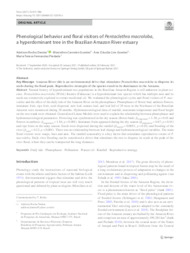Phenological behavior and foral visitors of Pentaclethra macroloba, a hyperdominant tree in the Brazilian Amazon River estuary.
Phenological behavior and foral visitors of Pentaclethra macroloba, a hyperdominant tree in the Brazilian Amazon River estuary.
Author(s): DANTAS, A. R.; GUEDES, M. C.; LIRA-GUEDES, A. C.; PIEDADE, M. T. F.
Summary: Natural history of hyperdominant tree populations in the Brazilian Amazon Region is still unknown in plant science. Pentaclethra macroloba (Willd.) Kuntze (Fabaceae) is a hyperdominant tree species which has multiple uses and its seeds are extensively explored to extract medicinal oil. We evaluated the phenological cycles and floral visitors of P. macroloba and the effect of the daily tide of the Amazon River on the phenophases. Phenophases of flower bud, anthesis flowers, immature fruit, ripe fruit, seed dispersal, new leaf, mature leaf, and leaf fall of 29 trees in the Northeast of the Brazilian Amazon were monitored during 28 months. Hydrometeorological data of rainfall, maximum temperature and flood height on the tree trunk were obtained. Generalized Linear Models were used to explain the relationship between phenophases and hydrometeorological parameters. Flowering was synchronized in the dry season (flower buds: ?temperature = 1.30, p < 0.01 and flowers in anthesis: ?temperature = 1.84; p < 0.001). Immature fruits appeared during the dry season (?temperature = 0.67; p < 0.01) and ripe fruits in the rainy season. Seeds were dispersed during the rainfall (?rainfall = 0.0051; p < 0.01) and flooding of the river (?water = 0.12; p < 0.001). There was no relationship between leaf change and hydrometeorological variables. The main floral visitors were wasps, bees and ants. The rainfall seasonality is a key factor that stimulates reproductive events of P. macroloba. Daily river flooding can be considered a driver that stimulates the tree to disperse its seeds at the peak of the river flood, where they can be transported the long distances.
Publication year: 2021
Types of publication: Journal article
Unit: Embrapa Amapá
Keywords: Daily tide, Phenophases, Pollination, Pracaxi, Pracaxi oil, Rainfall, Reproductive strategy
Observation
Some of Embrapa's publications are published as ePub files. To read them, use or download one of the following free software options to your computer or mobile device. Android: Google Play Books; IOS: iBooks; Windows and Linux: Calibre.
Access other publications
Access the Agricultural Research Database (BDPA) to consult Embrapa's full library collection and records.
Visit Embrapa Bookstore to purchase books and other publications sold by Embrapa.

